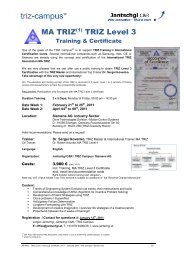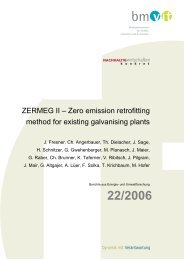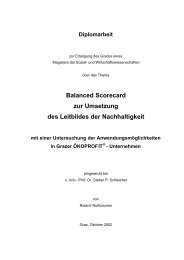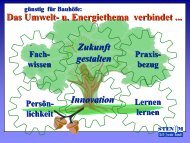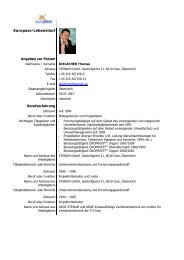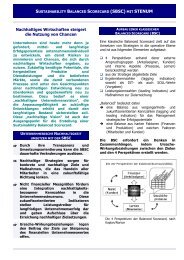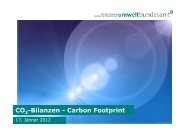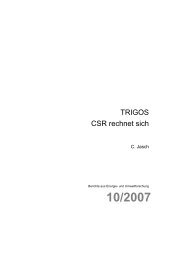Promoting Resource Efficiency in Small & Medium size ... - UNEP
Promoting Resource Efficiency in Small & Medium size ... - UNEP
Promoting Resource Efficiency in Small & Medium size ... - UNEP
You also want an ePaper? Increase the reach of your titles
YUMPU automatically turns print PDFs into web optimized ePapers that Google loves.
educe water use by 85%). Promote the use of condensatereturn<br />
systems for sterilisers.<br />
• Equip all vacuum sterilisers with mechanical vacuum systems.<br />
• Install dry-vacuum systems that do not use water for the pump<br />
seal.<br />
• Check type of fume hoods.<br />
• Check if hood scrubber is equipped with recirculat<strong>in</strong>g system.<br />
• Fume hoods should employ dry hood-exhaust systems<br />
wherever possible. Use recirculat<strong>in</strong>g systems <strong>in</strong> hood<br />
scrubbers.<br />
4.4.9 Office<br />
• Identify unnecessary water usage and fix leaks.<br />
• Use m<strong>in</strong>imum amounts of water to accomplish the task.<br />
• Recirculate water with<strong>in</strong> a process or group of processes.<br />
• Reuse water sequentially (e.g. use cascades).<br />
• Treat and reclaim used water.<br />
• Replace potable water supplies with water from non-potable<br />
sources where appropriate.<br />
• Install meters and probes (e.g. conductivity) on waterconsum<strong>in</strong>g<br />
equipment.<br />
• Install pressure-reduc<strong>in</strong>g valves.<br />
• Ra<strong>in</strong>water harvest<strong>in</strong>g is the process of collect<strong>in</strong>g, filter<strong>in</strong>g<br />
and stor<strong>in</strong>g water from rooftops, paved and unpaved areas<br />
for multiple uses. The harvested water can also be used for<br />
potable purposes after test<strong>in</strong>g and treatment. The surplus water<br />
after usage can be used for recharg<strong>in</strong>g groundwater aquifer<br />
through artificial recharge techniques. This can also result <strong>in</strong><br />
improv<strong>in</strong>g the quality of the groundwater e.g. lower fluoride<br />
content <strong>in</strong> groundwater. Ra<strong>in</strong>water harvest<strong>in</strong>g mechanisms are<br />
designed after assess<strong>in</strong>g the site conditions such as <strong>in</strong>cident<br />
ra<strong>in</strong>fall, subsurface strata and their storage characteristics,<br />
<strong>in</strong>filtration tests and by build<strong>in</strong>g suitable structures to collect<br />
and store ra<strong>in</strong>water.<br />
• A ra<strong>in</strong>water harvest<strong>in</strong>g system provides a source of soft, highquality<br />
water, reduces dependence on wells and other water<br />
sources and <strong>in</strong> many contexts is cost effective. A ra<strong>in</strong>water<br />
harvest<strong>in</strong>g system can range <strong>in</strong> <strong>size</strong> from a simple PVC tank to<br />
a contractor-designed and built sump. Ra<strong>in</strong>water systems are<br />
<strong>in</strong>herently simple <strong>in</strong> form.<br />
4.4.10 Water for clean<strong>in</strong>g and r<strong>in</strong>s<strong>in</strong>g<br />
• Sub-meter<strong>in</strong>g and monitor<strong>in</strong>g allows excessive water<br />
consumption and leaks to be quickly detected and corrected.<br />
• Use low-flow ‘fogg<strong>in</strong>g’ nozzles to r<strong>in</strong>se parts efficiently.<br />
• Use flow restrictors <strong>in</strong> water l<strong>in</strong>es that supply hoses and<br />
pressure washers.<br />
• Use timers to shut off process water r<strong>in</strong>ses when process is<br />
shut down.<br />
• Turn off runn<strong>in</strong>g water when not <strong>in</strong> use.<br />
• Ensure stationary spray nozzles are aimed properly.<br />
• Review nozzle spray patterns for optimum application. Fan,<br />
cone, hollow cone, air atomiz<strong>in</strong>g, f<strong>in</strong>e spray and fogg<strong>in</strong>g are a<br />
few examples of nozzle spray patterns.<br />
• Replace worn spray nozzle heads; they can result <strong>in</strong> poor spray<br />
patterns and excessive water consumption.<br />
• Use counter current wash<strong>in</strong>g techniques.<br />
• Use conductivity controllers to regulate r<strong>in</strong>se waterflow rates.<br />
• Use spray wash<strong>in</strong>g/r<strong>in</strong>s<strong>in</strong>g techniques for tank clean<strong>in</strong>g vs.<br />
refill<strong>in</strong>g/dropp<strong>in</strong>g tank wash-water.<br />
• Changes <strong>in</strong> the type, temperature and concentration of<br />
clean<strong>in</strong>g solutions can save water.<br />
• Overflow controls should be <strong>in</strong> place for fill<strong>in</strong>g tanks and<br />
vessels.<br />
• Cover hot water bas<strong>in</strong>s to avoid evaporation losses<br />
4.4.11 Boiler<br />
• Monitor blowdown rates, feed water quality and blowdown<br />
water quality regularly.<br />
• Install an automatic blowdown control that constantly<br />
monitors boiler water conductivity and adjusts the blowdown<br />
rate accord<strong>in</strong>gly to ma<strong>in</strong>ta<strong>in</strong> the desired water chemistry. A<br />
probe measures the conductivity and provides feedback to the<br />
controller driv<strong>in</strong>g a modulat<strong>in</strong>g blowdown valve. An automatic<br />
blowdown control can keep the blowdown rate uniformly<br />
close to the maximum allowable dissolved solids level, while<br />
m<strong>in</strong>imiz<strong>in</strong>g blowdown and reduc<strong>in</strong>g energy losses. Chang<strong>in</strong>g<br />
from manual blowdown control to automatic control can<br />
reduce a boiler’s blowdown water losses by up to 20%.<br />
• Implement or improve condensate return systems.<br />
• Improv<strong>in</strong>g external and <strong>in</strong>ternal feed water treatment.<br />
4.4.12 Steam system<br />
• Steam l<strong>in</strong>es and traps should be checked for leaks periodically<br />
and repairs should be scheduled.<br />
• Condensate should be recovered as much as possible<br />
4.4.13 Air condition<strong>in</strong>g<br />
• Consider recycl<strong>in</strong>g of air condition<strong>in</strong>g condensate water. This<br />
is achieved by modify<strong>in</strong>g the exist<strong>in</strong>g air condition<strong>in</strong>g dra<strong>in</strong>s<br />
to allow collection of the water and utilise where needed.<br />
4.4.14 Cool<strong>in</strong>g<br />
• Consider replac<strong>in</strong>g water-cooled equipment with air-cooled<br />
equipment.<br />
• Reuse the once-through cool<strong>in</strong>g water for other facility<br />
water requirements such as cool<strong>in</strong>g tower make-up, r<strong>in</strong>s<strong>in</strong>g,<br />
wash<strong>in</strong>g and landscap<strong>in</strong>g.<br />
• For most efficient cool<strong>in</strong>g <strong>in</strong> cool<strong>in</strong>g towers, the air and water<br />
must mix as completely as possible.<br />
• When the dew po<strong>in</strong>t temperature is low, the tower air <strong>in</strong>duction<br />
fans can be slowed by us<strong>in</strong>g a motor speed control or merely<br />
cycled on and off, sav<strong>in</strong>g both energy and water evaporation<br />
losses.<br />
• Reduction <strong>in</strong> drift through baffles or drift elim<strong>in</strong>ators will<br />
conserve water, reta<strong>in</strong> water treatment chemicals <strong>in</strong> the system<br />
and improve operat<strong>in</strong>g efficiency.<br />
• Replace or repair damaged baffles or drift elim<strong>in</strong>ators.<br />
• Optimisation of blowdown, <strong>in</strong> conjunction with proper water<br />
treatment, represents the greatest opportunity for water<br />
efficiency improvement.<br />
• To better control the blowdown and concentration ratio, <strong>in</strong>stall<br />
sub-meters on the make-up water feed l<strong>in</strong>e and the blowdown<br />
l<strong>in</strong>e.<br />
• M<strong>in</strong>imum blowdown rates must be determ<strong>in</strong>ed <strong>in</strong> tandem<br />
with the optimum water-treatment programme (<strong>in</strong>clud<strong>in</strong>g<br />
controll<strong>in</strong>g of parameters) for the cool<strong>in</strong>g tower as maximum<br />
concentration ratio for proper operation will depend on the<br />
feed water quality (pH, TDS, alkal<strong>in</strong>ity, conductivity, hardness<br />
and micro-organism levels)<br />
42



